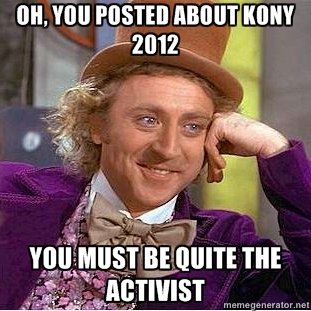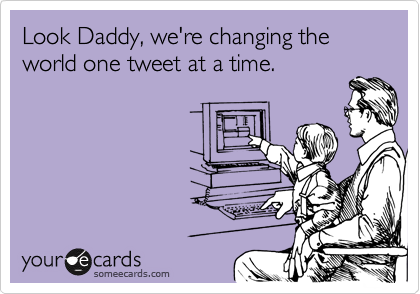
I wanted to delve a bit more into the analysis of the clicktivism/slacktivism concept, as I mentioned it in my post about 38 Degrees but almost just accepted it as successful campaigning action that should be emulated. While this is close to my personal view, there’s a lot of comment and literature on this concept and it’s merits and limitations. I won’t pretend this blog can cover all of the theorising on clicktivism, but hopefully it will give a bit more of an insight into some of the discourse.
This article and especially the comments below the line show the level of public debate raging on this issue. Brie Rogers Lowery, UK director of Change.org, describes the internet as having created the “biggest citizen megaphones ever”. I agree – the potential reach of the internet is huge; much bigger than a stall or public meeting. We increasingly live our lives digitally: using social media to maintain our relationships and apps exist for everything, so surely natural progression dictates that campaigning too will become digital?
Academically speaking, June 2014’s volume of the journal Politics and Internet contained a number of articles relevant to the clicktivism/slacktivism concept. One of these, Max Halupka’s article “Clicktivism: A Systematic Heuristic” [1] makes the point that academically, “clicktivism” is viewed in derogatory terms for the following reasons, which I’m going to try and counter:
– it’s ineffective
We don’t know for sure that it is effective, as there is a lack of empirical evidence on the causes of such change [2], but there are lots of examples of efficacy in specific-issue campaigns, such as 38 Degrees’ forests petition which I previously mentioned, or the Tanzanian Masai gaining land security after Avaaz’s international efforts which involved 1.7m participants.
– it contributes further to political disengagement
I would suggest that this criticism is dependent on not viewing e-campaigning itself as political engagement. While engagement with ‘formal’ politics (voting, membership of parties) is suggested to be in decline, the numbers getting involved with actions online are huge – nearly 18m actions taken via 38 Degrees, for example.
There is an argument that simple, online action such as clicking ‘Like’ “displaces” bigger, more worthy action elsewhere. David Babbs, CEO of 38 Degrees states in the Guardian article linked above:
“That critique is dangerously elitist – as if you have to earn your stripes as an activist. If you believe in democracy, surely the easier it is to participate in the better. That’s the power of the internet.”
– it’s driven by a desire for self-satisfaction/smugness
I imagine the same charge could be levied at real-life marchers and petitioners. Even if it is self-satisfying, does this make online action worthless? Surely feeling good about oneself is a happy by-product of taking action?
– it’s too easy: change should be hard!
Why should change be hard? The whole point of my previous article was that it should not be difficult to engage politically. Online activism arguably takes away some barriers to mobilisation – e.g. physical distances between actors, availability of information, ability to send communications etc, which can only be a good thing in encouraging engagement.
– it’s impulsive/spontaneous and non-committal
In “New Media, New Civics?” [3] Ethan Zuckerman presents “axes of participatory civics”: thick/thin participation, to achieve voice/instrumental change.
![Zuckerman's "axes of participatory civics", in [3], p159](https://reflectionsoncampaigning.files.wordpress.com/2014/11/axes-of-participatory-civics.gif?w=152&h=152)
Zuckerman’s “axes of participatory civics”, in [3], p159
The participation axis is a continuum between derided “thin” actions (don’t require thought – participants just have to ‘turn up’: things like clicking ‘like’, online petitions, sharing items or changing a profile picture) and “thick” actions (involving the planning of the campaign and developing the theory of change), which are thought of as more legitimate.
The objectives axis is divided into “voice” – an expression of dissatisfaction, and “instrumental”, which include a clear aim such as a law to pass or block. While some might discredit the “voice” strand as pointless, Zuckerman cites the work of economist Hirschmann in 1970 stating that by using voice engagement, activists can set agendas, collectivise and, as I personally believe, act as a first step for people to become more deeply involved.
Campaigning should encompass diverse tactics and people, and Zuckerman’s axis illustrates this for me. We can’t all start planning occupations; for some of us signing a petition is as risky as we are willing or able to get, and being involved in this way is surely better than doing nothing.
Halupka describes online campaigning is a “legitimate political act” [1] throughout his article. Zuckerman suggests that in future, it will be the expected norm that activism will be hybrid in its approach, using both online and more traditional offline tactics.
I certainly hope so – I feel that the debate over online action overshadows some of its success. People often seem unwilling to embrace change – but really all that’s changing is the medium: tactics, such as clever framing, storytelling etc are still being used. Changing a profile picture might equate to pre-social media bumper stickers or badges, and online petitions to paper ones!

- Halupka, M., “Clicktivism: A Systematic Heuristic” in Policy and Internet, Volume 6, Issue 2, pages 115-132, June 2014
- Freelon, D., “Online Civic Activism: Where Does It Fit?” in Policy and Internet, Volume 6, Issue 2, pages 192–198, June 2014
- Zuckerman, M., “New Media, New Civics?” in Policy and Internet, Volume 6, Issue 2, pages 151-168


![Zuckerman's "axes of participatory civics", in [3], p159](https://reflectionsoncampaigning.files.wordpress.com/2014/11/axes-of-participatory-civics.gif?w=152&h=152)
